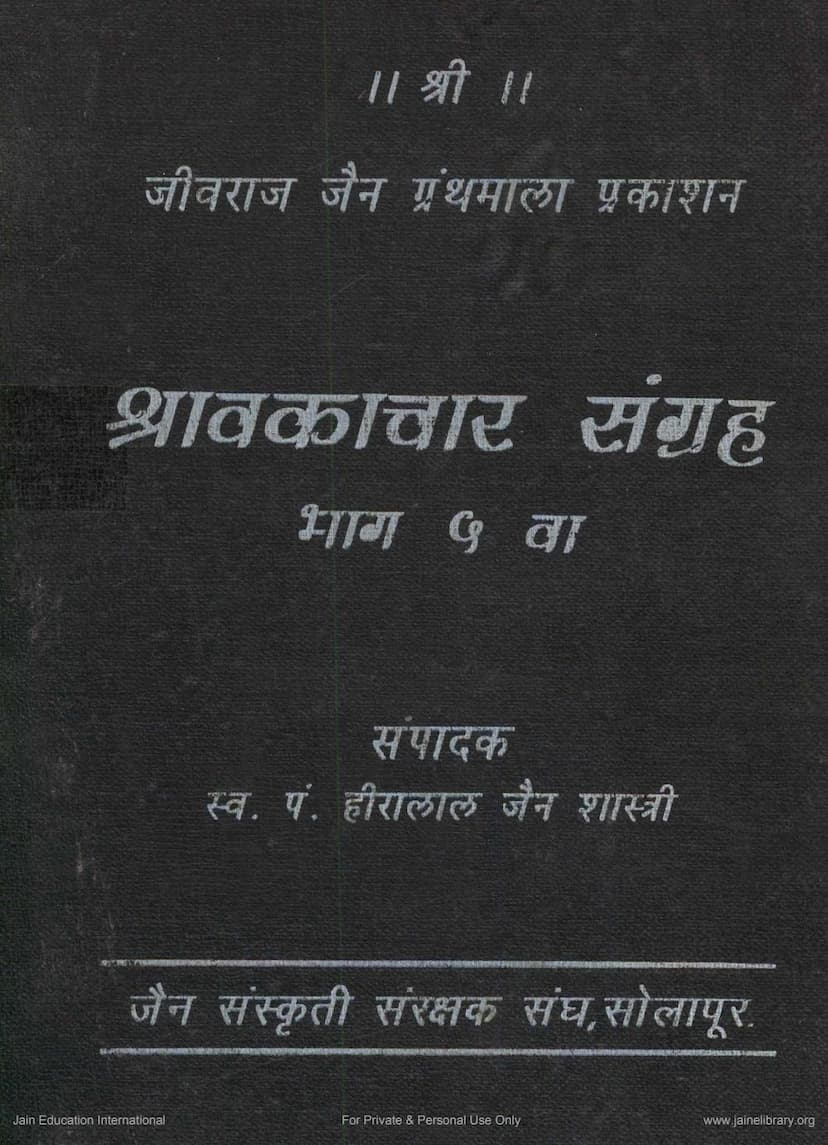Sharavkachar Sangraha Part 5
Added to library: September 2, 2025

Summary
This Jain text, Sharavkachar Sangraha Part 5 (श्रावकाचार संग्रह भाग ५), compiled by the late Pt. Hiralal Jain Shastri, published by the Jain Sanskriti Samrakshak Sangh Solapur, is the fifth volume in a series dedicated to preserving and propagating Jain lay conduct literature (Shravakachar).
This particular volume is a compilation of Jain lay conduct texts written in Hindi verse, along with two Kriyakoṣa (क्रियाकोष) texts. The editor and translator, the late Siddhantacharya Pt. Hiralal Shastri, was a renowned scholar of Jain philosophy.
The volume features three primary works:
-
Padam Kavi's Shravakachar (पदम कवि कृत श्रावकाचार):
- Composed in Gujarati-mixed Rajasthani language, this work describes 53 specific actions (Trepana Kriya - त्रेपन क्रिया) of a lay follower.
- The poet Padam indicates the completion of his work in Samvat 1615.
- His guru lineage is traced back through a line of distinguished Bhattarakas.
- Padam Kavi was inspired by earlier works like Samantabhadra's Ratnakaranda Shravakachar, Vasunandi's Shravakachar, Ashadhar's Sagardharmamrita, and Sakalkirti's Shravakachar.
- The text is noted for its detailed exposition of various principles, including the 53 actions, the nature of right faith (Samyaktva), the eight limbs of Samyaktva, and the twelve vows of a lay follower. It also describes the 11 stages (Pratima) of lay discipleship and delves into the faults of associating with wrong beliefs and practices.
-
Pt. Kishan Singh Ji's Kriyakoṣa (श्री किशनसिंह जी का क्रियाकोष):
- Completed in Samvat 1787 in Sanganer, Rajasthan.
- Kishan Singh Ji was a resident of Rampura.
- His work is praised for its comprehensive description of prohibited (Abhakshya) foods and detailed explanation of the 53 actions.
- He also addresses contemporary social practices and superstitions, advocating for their abandonment in favor of Jain principles.
- The text includes descriptions of rituals related to women during menstruation and childbirth, as well as details on the proper conduct in Jain temples.
- Kishan Singh Ji cites scriptures and quotes from earlier works to support his points.
- Notably, his work shows influence from the Veespanth tradition, with emphasis on practices like tying a cloth over the mouth during idol worship, which was prevalent among Shvetambara Jains and historically among some Digambara Jains.
-
Pt. Daulat Ram Ji's Kriyakoṣa (श्री दौलत राम जी का क्रियाकोष):
- Composed in Samvat 1795 in Udaipur.
- Daulat Ram Ji is recognized for his deep knowledge across all four branches of Jain scripture (Anuyogas).
- His writing style is appreciated for its emotional depth, simplicity, and engaging narrative.
- He elaborates on concepts like non-violence (Ahimsa), truthfulness, non-stealing, celibacy, and non-possession, detailing their virtues and prohibitions.
- The work is noted for its thorough discussion of the 53 actions, prohibited foods, and the significance of purity in daily life, including food preparation and consumption.
- Daulat Ram Ji's contribution is significant for its detailed analysis of the 17 rules for lay followers and the importance of devotional practices.
- His work also includes critical commentary on incorrect beliefs and rituals, contrasting them with the correct Jain path, and highlights the significance of Jain idol worship with scriptural reasoning.
Key Themes and Content:
- Shravakachar (Lay Conduct): The core focus is on the daily life, ethical conduct, and spiritual practices of Jain lay followers.
- Trepana Kriya (53 Actions): The compilation details these specific actions that a lay follower should observe and practice for spiritual purification.
- Vows and Principles: The texts elaborate on the fundamental Jain vows (Mahavratas and Anuvratas), principles of non-violence (Ahimsa), truthfulness, non-stealing, celibacy, and non-possession.
- Purity and Rituals: Emphasis is placed on purity in daily actions, food, water, and adherence to prescribed rituals.
- Spiritual Practice: The importance of right faith (Samyaktva), right knowledge (Samyak Gyana), and right conduct (Samyak Charitra) is highlighted, along with practices like meditation and devotion.
- Critique of Superstitions: The texts also address and refute various prevalent superstitions and incorrect religious practices, advocating for adherence to scriptural teachings.
- Biographies and Lineage: The works include brief introductions to the poets and their guru lineages, providing historical context.
- Comparative Analysis: The editor's note provides a comparative analysis of the three texts, highlighting their similarities and unique contributions.
The volume serves as a valuable resource for understanding the detailed code of conduct for Jain lay practitioners, offering guidance on daily rituals, ethical living, and spiritual progression within the Jain tradition. The preface mentions the inspiration provided by Dr. A. N. Upadhye, a distinguished scholar, for the publication of this collection. The publication is dedicated to preserving and promoting Jain culture and literature.